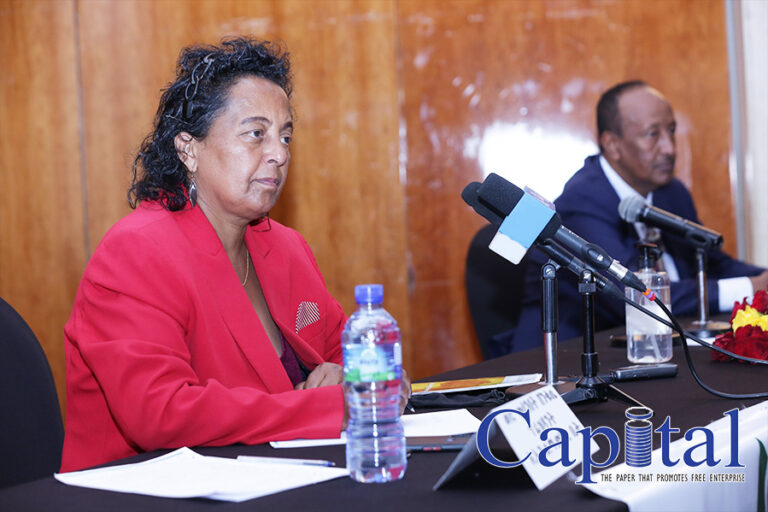Month on month general inflation rate in January 2022 caps at 34.5 percent showing slight decrease from 35.1 percent in December, the Central Statistics Service reveals.
According to the monthly inflation rate report of the statisticians, the month on month food inflation rate for January 2022 decreased by 1.7 percentage points in comparison to the preceding month, however, during the similar period, the non-food inflation rate increased by 0.7 percent.
On similar trends, the ‘12 months Moving Average Inflation rate’ at country level rose by 28.1 percent in January 2022 when compared to a similar period of a year back. The country level food inflation increased by 33.1 percent as compared to last year similar period while the country level non-food inflation rate increased by 21.5 percent. Most of the components of the food index showed increase as compared to a similar period of last year.
Likewise January 2022 General year-on-year inflation has increased by 34.5 percent when viewed against January 2021. The year-on-year food inflation to that regard has peaked at 39.9 percent.
In the current month, cereals and vegetables in addition to teff, wheat, barely, maize and sorghum have shown a decline in most cases. However, meat, milk, cheese, eggs, and spices (mainly salt and pepper) have slightly increased in the current month. Cooking oil and butter prices similarly have shown increase.
Additionally, coffee beans and non-alcoholic beverages prices have also increased consistently.
When looking into non-food inflation, an increase of 27.3 percent in January 2022 has been seen. The rise in non-food Inflation is mainly due to rise in the prices of alcohol, tobacco, stimulants (chat), clothing and footwear, housing repair and maintenance (House rent, cement and corrugated iron sheets). Also adding to the weight on the list is the rise in price of energy (firewood and charcoal), furniture and home furnishings, fuel, medical care and jewelry (gold).
The month-on-month general Consumer Price Index (CPI) for January 2022 has showed a slight increase of 1.2 percentage points while the food item CPI in complementary trend showed increase by 0.8 percentage points as compared to the preceding month of December 2021. In similar fashion a 1.6 percent increase has been note for non-food CPI showed for the same period.
The monthly inflation rate measures the price change between the two latest months. Although up to date, it can be affected by seasonal and other short term effects.
Monthly inflation shows slight decrease
Trade policy deemed crucial in up scaling local, international commerce
Crafting a trade policy has been underlined as a crucial move to augment Ethiopia’s trade and export.
During the discussion that Addis Ababa Chamber of Commerce and Sectoral Association (AACCSA) held with regards to the export sector, Shibeshi Bettemariam, Acting Secretary General of AACCSA, on his inception presentation expressed his hope that the new incoming policy will bring change for trade in general and for export in particular.
Shibeshi said that lack of similar policy was one of the major reasons for the stagnation of Ethiopia’s export in terms of earning and diversification. Challenges like low production, productivity and low value addition, limited quality and standards of export goods, and lack of comprehensive trade policy were stated as the Achilles’ heel of the export sector.
For the 8 year period of 2010/11-2018/19, the import and export of Ethiopia’s goods and services had grown by 4.3 percent and 10.46 percent respectively.
He said that the trade balance has consistently been negative, with average deficit per year standing at USD 10.6 billion. Of these, the peak was USD 13.8 billion in 2015/16, while imports have been more than double the exports in almost all years.
Figures that were included on the study conducted by the chamber indicated that in the last ten years the export trade contributed on average only 5.5 percent of the GDP, which is razor thin when compared to other countries.
“At the same time the import trade contribution for the GDP is 23.3 percent on average which shows the largest gap between export and import,” the Acting Sec. Gen remarked.
He added that compared to regional economies such as Tanzania, Uganda, Rwanda and Kenya, Ethiopia’s export performance as a percentage of GDP was the lowest, implying our economy has been classified as relatively closed.
“The country is joining continental and international free trade areas but because of productivity and efficiency at the current status we can’t compete with other countries around the region,” he said, adding, “the gap on the private sector must be identified and solved.”
He emphasized that the private sector is the pride of the country and the flag carrier in the global market competition rather than the government, thus it is wise to keenly focus on export development through the private sector.
“To attain the required growth, a trade policy is crucial,” Shibeshi said.
According to the expert, who is an economist by profession and an investor, trade policies are a necessity, and even seat atop of the international relations agenda for countries that even have trade policy negotiators that specialize on market intelligence and statistics, in addition to lawyers in diplomatic missions. He emphasizes that as a country, we ought to emulate the same.
Ethiopia export’s puzzling challenge is one that is seen to be solved through structural arrangement and policy.
The agricultural productivity is crucial to expand the expected growth since the ecosystem of the country is a good advantage followed by agricultural processing.
Trade logistics improvements in the areas of technology like the telecom infrastructure are crucial to conduct frequent and speedy communication. Allocating efficiently the earned foreign currency through administrative measure has also been stated as a supportive measure that will expand export.
The trade policy that is currently under drafting stage is the main pillar for the export sector.
The new policy will center different government directions and policy contents that are related with trade and export.
“Currently trade and trade related issues are included under industrialization policy, different five year development plans, and other policies that shall be governed independently and proactively through structural manner in the new trade policy,” he added.
Shibeshi reminded that there were efforts to expand the export commodity diversification, though they could not materialize as per the expectation because of different reasons. He gave an example of the failure in the pharmaceutical sector which faced the market challenge and access to finance. However in the past over a decade up to three sectors like horticulture products, and textile and garment have diversified the composition of Ethiopian export.
Export facilitation services are stated as crucial and are to be largely included on the trade policy similar to other countries. Export trade results have been in flux since 2011 to which the trajectory showed some improvements in 2020 and in the last budget year.
The government through Ministry of Trade and Regional Integration is responding to disappointing results in both local and international commerce by drafting its first trade policy.
The policy will evaluate everything from scratch and indicate the end goal of the commercial sector and will show the actors and contributors in commerce.
Crafting the policy started in 2019 and has taken much time to which experts said that it has faced delays since the policy work ought to include international experts’ view thus having wider validations.
Besides the export trade, in the local market hording, smuggling, overstating price increases, and uncontrollable and lack of adequate supply in terms of goods and services have been major problems over the past several years. The Ministry has attempted to come up with solutions by imposing laws and controlling mechanisms to smash illegality and or supply products on its own but things have not improved.
Green Tech joins Ethiopia’s electric car space
Green Tech Ethiopia introduces six models of imported rechargeable solar and electric powered cars with the aim to promote renewable energy in the country.
“Our company is established with the aim to promote renewable energy in our society by providing new renewable energy technologies and services including different types of affordable electric and solar cars,” said Fitsum Deresa, Managing Director of Green Tech Ethiopia.
The company imported the cars from Chinese car manufacturer Dongfeng Motor Corporation and has plans to establish a car assembly factory in the near future.
“From the six different electric car models so far 70 have arrived in Addis Ababa while additional 200 cars have reached Djibouti port,” Fitsum explained. The company also plans to import 5000 electric cars within the coming 5 years and is also planning to delve in to the transportation industry through its “green transport initiative service.”
Similarly, in order to support the middle and low income societies and promote entrepreneurship in the country, the company has facilitated a 40/60 electric car sale package to its potential customers.
“The financing scheme will help all our potential customers to secure automobiles enabling them to create income streams for themselves and their families in the process” stated the green company. To this end, Green Tech is working with Africa Village micro finance and other banks.
As the managing director indicated, 60 percent of the payment will be covered by customers and Green Tech will cover the remaining 40 percent. Customers can pay 30% of their 60% ownership which is only 18 percent of the total price to purchase their cars and the remaining 70% payment will be down paid as per the directives of the agreement.
Of course the energy cost that powers the cars is a huge point in getting one of these auto mobiles. For instance the solar charged electric cars can travel 60-120 kilometers. The 4 seater automobiles have a 26kWh capacity and with full charge can be driven to a distance of 200km with only 9.10 birr while that of the minibus can be driven to a distance of 360km once its 80kWh battery is fully charged with only 28 birr. With the price of gas being sold at 31 birr per liter, this is definitely worth the interest of any prospective buyer. Similarly, the cars also present a minimum maintenance cost which is very beneficial to its future owners.
Of benefit to Green Tech is that the green movement is very much needed in Ethiopia. In fact the government has a resilient vision that encourages the use of electric vehicles to help reduce pollution caused by transportation services through introducing renewable energy transport services.
Green Tech Ethiopia now becomes the second firm to officially enter the electric cars market in the country after Marathon Motors.
Ethiopia exports over 2.7 million kilos worth of flowers for valentines
Ethiopia exports over 2.7 million kilograms of flowers for the lovers’ day which will be celebrated tomorrow.
The Ethiopian horticulture sector which scaved the global pandemic effect unlike other sectors, has registered yet another success on the ‘Valentine’s Day’ market, which is one of the peak seasons for the floriculture business.
The statement that Ethiopian Horticulture Producer Exporters Association (EHPEA) sent indicated that in related with romantic holiday days the export has been boosted to almost 2714.45 tones.
“As the world celebrates love on February 14, 2022, Ethiopian flower growers exported 2714.45 tonne of flowers for valentine day to the global market with in the time period of February 1st to 13th, 2022,” EHPEA said on its statement.
Despite it is the late comer on the export basket the horticulture sector has achieved spectacular successes. Even when the sector severely affected by COVID 19 the Ethiopian export earning from the horticulture industry, which takes on average 15 percent of the total export earnings, was massive.
One of the major reasons for the achievement is the strength of Ethiopian Cargo and Logistics Services, who converted its passenger aircrafts besides the existed cargo fleets, when the pandemic forced global aviation business to ground.
In this pick season Ethiopian Airlines is also providing shipment service for Kenyan flower growers, who are the top exporters in the continent before Ethiopia.
Over the past decade, Ethiopia has been one of the world’s major providers of quality cut flowers to the global market, with a total export value of 530 million EUR per year which puts the country on the 5th level among the top flower export countries.
“Valentine’s Day is very important for the country’s flower sector as its one of the holidays the flower industry flourishes and increased production from 35 percent to 40 percent,” EHPEA, which is also one of the strongest sectoral association in the country, said.
In the first six months of the 2021/22 budget year the country secured USD 287 million from the export of flower, fruit and vegetable. The earnings is attained over seven percent from the projection that the government set to achieve in the stated period.
From the total earnings the follower export share was USD 246.5 million that climbed by 16 percent compared with the same period of last year and six percent from the projection.
It added that the favourable climate conditions have made Ethiopia the best cultivation site for horticulture products as it is situated in the tropics, with its diverse range of altitudes, “the cost of doing business climate is becoming expensive in other countries and its cheaper in Ethiopia as the government allotted different incentives which attracted many foreigners to set up flower farms in Ethiopia.” Currently, the floriculture investment in all over the country is 1600 hectare.
Even though the horticulture industry is young for the country, it has significantly contributed to economic, social and environmental development which also managed to generate more than USD four billion so far to the country.
One of the major successes tapped from the horticulture sector is the job opportunity and women empowerment.
The sector created job opportunities for close to 200,000 Ethiopians where 85 percent of them are women. The knowledge transfer from the sector has also contributed for the livelihood improvement of millions of Ethiopians as well.
EHPEA that established in 2002 and have 120 members has worked relentlessly to improve the industry business climate with in the country through its strategic advocacy intervention areas.






